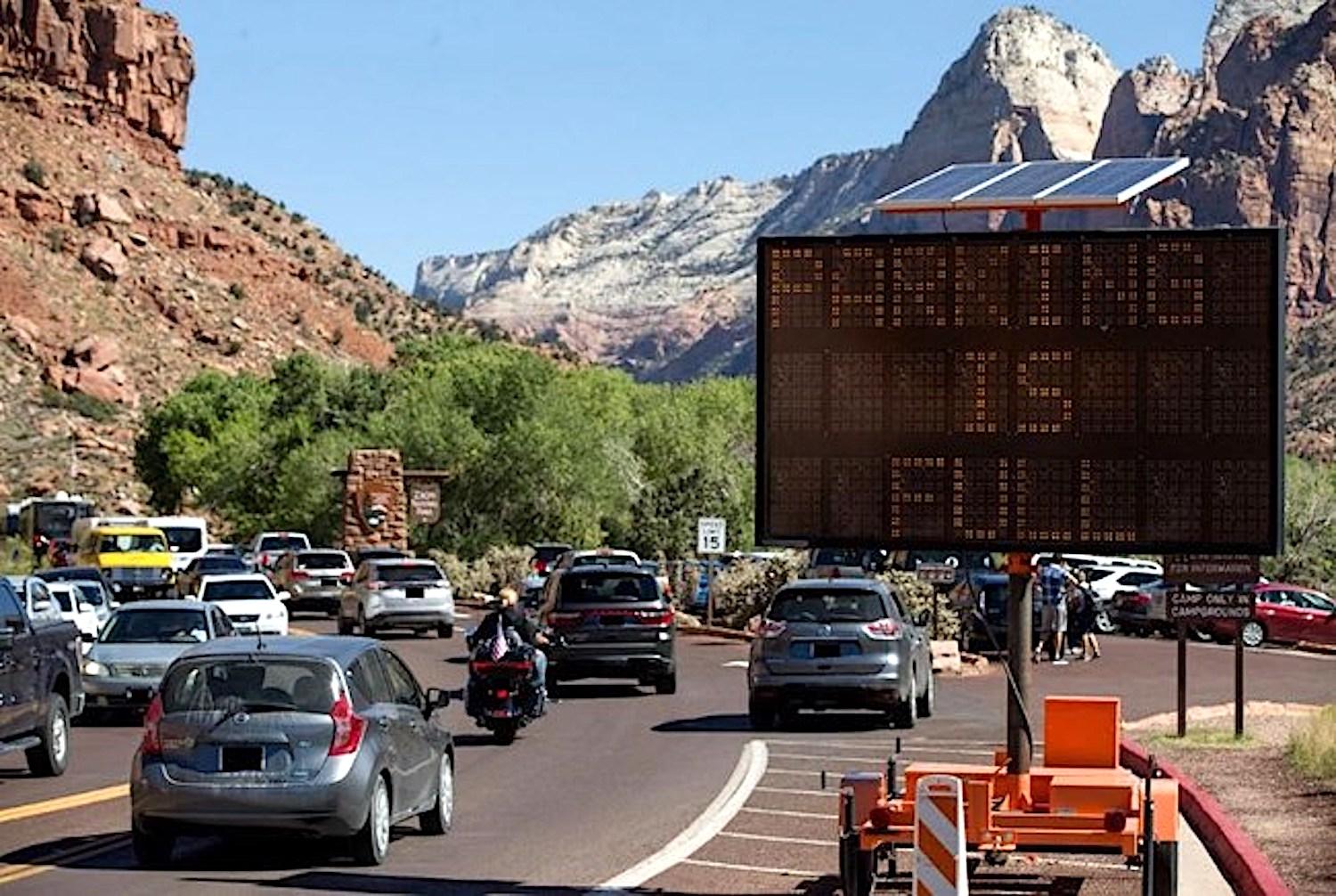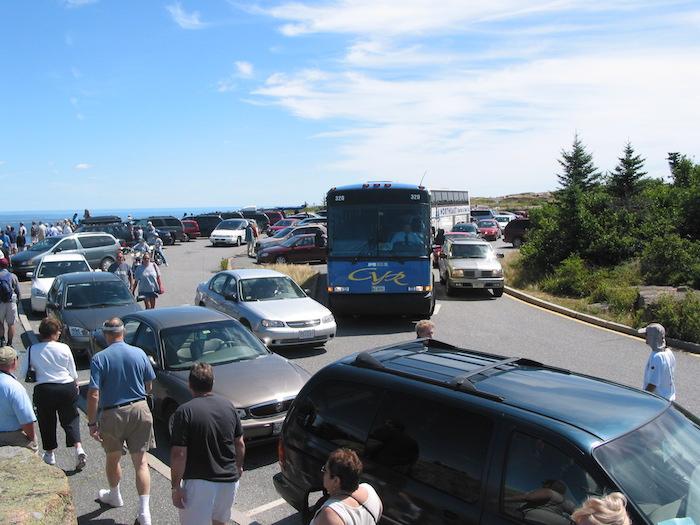
Visitors can create headaches for national park gateway towns, but they also bring substantial revenues/NPS
Gateway Towns Grateful For National Park Visitors, But...
By Lori Sonken
Editor's note: This corrects Moab's population. It's roughly 5,300, not 53,000.
Kim Cloud circled the parking lot at Jordan Pond House, a popular and scenery blessed gift shop and restaurant known for popovers in Acadia National Park. She passed cars parked on the curb – their owners ignored the no parking signs -- and resisted the temptation to follow those who left their vehicles in spots reserved for RVs.
“By 9:30 a.m., the place looked like Disney World,” said Cloud, who traveled from New Jersey to Acadia in mid-August.
Tourists create traffic jams, make parking difficult, and increase police calls in national park gateway communities. But they also generate revenues used to support town amenities, including community centers, parks, trails, sidewalks, police, and water treatment facilities, in small towns across the country. For the small town leaders, the crush of high-season visitation has forced them to balance business against community needs and concerns.
“On any given day we have as many or more visitors than local residents,” said Tawny Knuteson-Boyd, a member of the Moab (Utah) City Council. Located just outside Arches National Park, and less than an hour from Canyonlands National Park and Dead Horse Point State Park, Moab has 5,300 full-time residents and sees 3-5 million annual visitors drawn by the red-rock park landscapes and surrounding U.S. Bureau of Land Management lands.
Other towns outside national parks face a similar visitor influx. For example, there were 782,000 visits to Acadia in July – a record high, said John Kelly, management assistant to the park’s superintendent.
Tourists stopping in Bar Harbor –- population 5,000 year-round –- on their way to and from Acadia generate income for the town. The crowds provide a “much needed shot in the arms,” especially after last year's struggle with Covid, said Alf Anderson, executive director of the Bar Harbor Chamber of Commerce.
Due to Covid-19, Acadia reduced campground capacity this year. Unable to reserve a tent camping spot in the national park through reservation.gov, Cloud stayed at a nearby commercial campground. The eighth-grade science teacher, traveling with her two daughters, also went on a whale watching tour from Bar Harbor.
Parks And Their Gateway Towns Struggle To Manage Visitors
In a bid to reduce congestion and resource damage atop Cadillac Mountain, Acadia officials this year implemented a reservation system for drivers wanting to reach the summit. A month before her trip, Cloud spent $6 to pre-book an early-morning reservation to Cadillac Mountain. There was ample parking at the summit, but by the time she left several hours after the fog lifted, spots were limited. (There are no limits on how long one can park atop Cadillac Mountain.)

Prior to the reservation system, traffic got jammed quite a bit atop Cadillac/NPS file
Through social media and its website, the park encourages people to make reservations before they visit and to plan ahead. “The challenge is people are coming without planning ahead,” said Kelly. About 30 percent of those arriving at the park do not know reservations are required to summit Cadillac by vehicle.
Across the country at Rocky Mountain National Park in Colorado, officials prompted by Covid to better manage visitation have required visitors during the peak summer and early fall seasons to purchase timed-entry passes from recreation.gov. This requirement does not apply to those on a commercial or guided trip.
Arches, which often closed its entrance this summer due to traffic backing all the way up to U.S. 191, is debating whether to implement a timed-entry system similar to the one at Rocky Mountain where officials, by the way, are discussing long-term efforts to better manage visitation to reduce congestion and make visits more appealing.
“This would help a lot with cars backing up on the highway from the entrance,” said Moab Councilmember Knuteson-Boyd.
The National Park Service has scheduled two public meetings virtually this week (on Wednesday and Friday) to discuss how an Arches reservation system might work, as well as a proposed shuttle and other efforts to reduce traffic congestion. Public comments will be taken through October 5, said Kate Thomas, the park's public affairs specialist.
Spreading Out The Visitors
Back at Rocky Mountain National Park, the timed-entry requirements “have spread the weekend afternoon peak visitation over longer hours and days of the week,” said Gregory Muhonen, public works director in Estes Park, the park's eastern gateway town.
This year, approximately 2.5 million people visited Rocky Mountain, similar to the number of visitors in 2019. Compared to last year -– when the pandemic kept people home-- this year's visitation is up 74 percent, according to the town’s economic dashboard.
Also up are the town's tax revenues, which are running more than $2 million ahead of 2019's pace, when visitation levels mirrored this year.
Sales tax revenues are also up in Springdale, Utah, adjacent to Zion National Park. The town generated $3.9 million in sales tax revenues from July 2020 through June 2021 – significantly more than the $74,000 in property taxes collected from the 660 permanent residents.
Thanks to revenues from outsiders, property taxes in Springdale have remained constant the past 30 years, said Rick Wixom, town manager the past 17 years and local hotel owner.
Moab has no municipal property tax. Recently, one was proposed but “the whole town, including those on the left and right of the political spectrum said ‘no way,'” said Mike Duncan, a member of the Moab City Council. “In my view, it’s the same old story. Everyone wants their amenities but wants someone else to pay for them.”
Gateway communities are taking steps to reduce traffic. Springdale shuttles visitors from the parking lots in town to Zion. Similarly, Bar Harbor’s Island Explorer takes tourists to and from Acadia. Moab is piloting a program to use passenger vans to shuttle residents to work.
“We are implementing strategies to attract guests who will stay longer and spend more, leading to fewer guests overall while positively affecting economic growth,“ said Rachel Oppermann, marketing and communications manager with the destination marketing organization, Visit Estes Park.
Estes Park has done a good job of creating bypasses around the streets” to eliminate congestion, said John Lefever, resident of Longmont, about 40 miles from Estes Park. Still, even with the bypasses, he avoids Estes Park on weekends.
Travel time through downtown Estes Park decreased this year, despite an increase in vehicles, pedestrians, and park visitation. Similarly, daily vehicle trips to and from Estes via US 34 and US 36 dropped in 2021.
But police incidents are up in Estes Park, especially compared to 2019 and 2020, said Captain Corey Pass. “Our 911 calls have increased 17 percent since 2019,” he said. Arrests and citations actually declined, but more people are calling to ask directions and request assistance.
Visitors = $$
For the first time, this year Estes Park has been charging for parking in eight of 18 parking lots. Through August 15, parking generated $514,000, said Muhonen. By ordinance, the parking revenue can only be used on public parking and transit-related expenses.
Bar Harbor expects to receive $2 million in parking revenues this year, up from $1.5 million in 2019, said Anderson. The parking revenues support infrastructure.
In Springdale, visitors used to park on both sides of the three-mile-long main road, blocking local residents’ driveways. The town resembled a “metal canyon,” before parking was restricted to one side of the street, said Mayor Stan Smith.
Now, Springdale charges from $12 to $20 per day for parking. The closer the parking space is to Zion, the more expensive it is. As in Bar Harbor, those revenues support parking infrastructure expenses in Springdale.

Arches with its red-rock wonders is a powerful magnet for visitors/Kurt Repanshek file
In the 18 years Knuteson-Boyd has lived in Moab, she has noticed lots of changes, including a traffic light at the entrance to Arches National Park, more people living in their cars or camping full-time out of necessity, and recently two murders on nearby U.S. Forest Service lands.
Most visitors are well-behaved. But “there are just enough bad house guests that create a conflict with locals,” she said. It is a problem not unique to Moab but one that the city is taking steps to address, including by adding parking to core downtown areas, prohibiting new hotel construction, and building low-income housing.
“The parks are not the main drivers of anything. There are so many pieces to the puzzle that impact our community,” Knuteson-Boyd said.
But the parks are what draws people to the area, and they are the first to be criticized when problems arise.

Comments
living in Estes Park for 36 years ,a heavy user of R.M.N.P., the spontanaity has gone away. Much preplanning, extra reservation fees, casual drivethru not possible, have diminished the experience. Many non-locals, not aware of reservation rquirements are disappointed being turned around at entry station. Social media proclaims the beauty of the parks and too many folks are seeking the experience--overcrowding-- requireing management restictions.